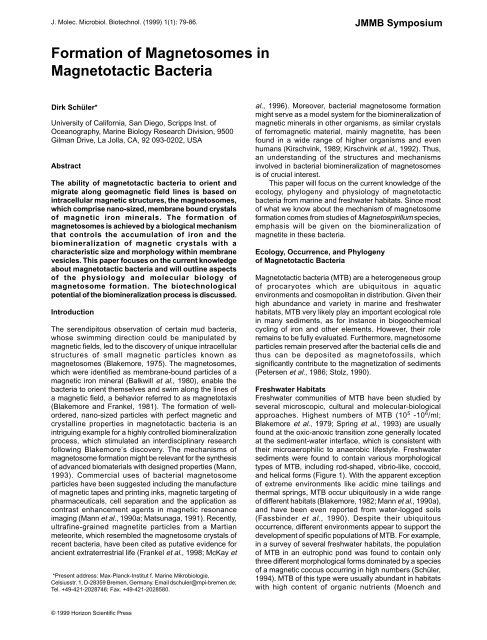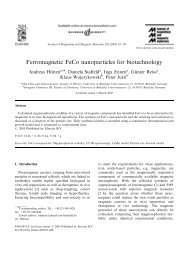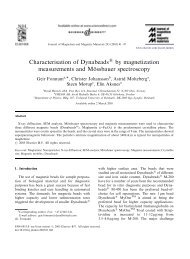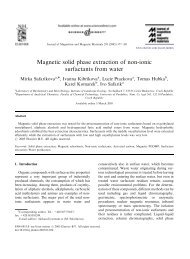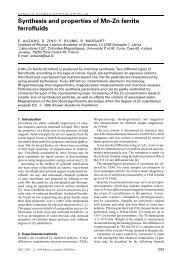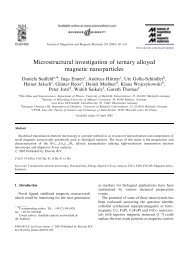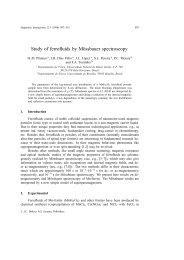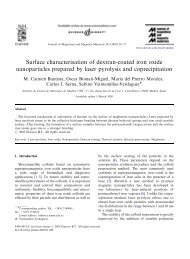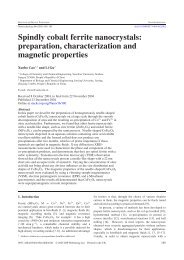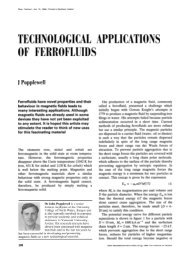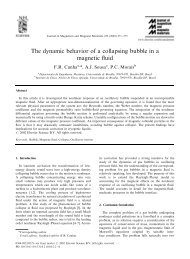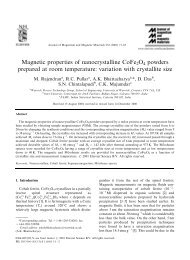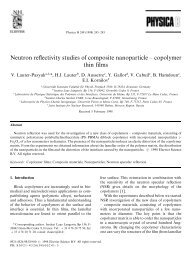Dirk Schuler. Formation of magnetosomes in magnetotactic bacteria
Dirk Schuler. Formation of magnetosomes in magnetotactic bacteria
Dirk Schuler. Formation of magnetosomes in magnetotactic bacteria
- No tags were found...
You also want an ePaper? Increase the reach of your titles
YUMPU automatically turns print PDFs into web optimized ePapers that Google loves.
J. Molec. Microbiol. Biotechnol. (1999) 1(1): 79-86.JMMB SymposiumBacterial Magnetosome <strong>Formation</strong> 79<strong>Formation</strong> <strong>of</strong> Magnetosomes <strong>in</strong>Magnetotactic Bacteria<strong>Dirk</strong> Schüler*University <strong>of</strong> California, San Diego, Scripps Inst. <strong>of</strong>Oceanography, Mar<strong>in</strong>e Biology Research Division, 9500Gilman Drive, La Jolla, CA, 92 093-0202, USAAbstractThe ability <strong>of</strong> <strong>magnetotactic</strong> <strong>bacteria</strong> to orient andmigrate along geomagnetic field l<strong>in</strong>es is based on<strong>in</strong>tracellular magnetic structures, the <strong>magnetosomes</strong>,which comprise nano-sized, membrane bound crystals<strong>of</strong> magnetic iron m<strong>in</strong>erals. The formation <strong>of</strong><strong>magnetosomes</strong> is achieved by a biological mechanismthat controls the accumulation <strong>of</strong> iron and thebiom<strong>in</strong>eralization <strong>of</strong> magnetic crystals with acharacteristic size and morphology with<strong>in</strong> membranevesicles. This paper focuses on the current knowledgeabout <strong>magnetotactic</strong> <strong>bacteria</strong> and will outl<strong>in</strong>e aspects<strong>of</strong> the physiology and molecular biology <strong>of</strong>magnetosome formation. The biotechnologicalpotential <strong>of</strong> the biom<strong>in</strong>eralization process is discussed.IntroductionThe serendipitous observation <strong>of</strong> certa<strong>in</strong> mud <strong>bacteria</strong>,whose swimm<strong>in</strong>g direction could be manipulated bymagnetic fields, led to the discovery <strong>of</strong> unique <strong>in</strong>tracellularstructures <strong>of</strong> small magnetic particles known as<strong>magnetosomes</strong> (Blakemore, 1975). The <strong>magnetosomes</strong>,which were identified as membrane-bound particles <strong>of</strong> amagnetic iron m<strong>in</strong>eral (Balkwill et al., 1980), enable the<strong>bacteria</strong> to orient themselves and swim along the l<strong>in</strong>es <strong>of</strong>a magnetic field, a behavior referred to as magnetotaxis(Blakemore and Frankel, 1981). The formation <strong>of</strong> wellordered,nano-sized particles with perfect magnetic andcrystall<strong>in</strong>e properties <strong>in</strong> <strong>magnetotactic</strong> <strong>bacteria</strong> is an<strong>in</strong>trigu<strong>in</strong>g example for a highly controlled biom<strong>in</strong>eralizationprocess, which stimulated an <strong>in</strong>terdiscipl<strong>in</strong>ary researchfollow<strong>in</strong>g Blakemore’s discovery. The mechanisms <strong>of</strong>magnetosome formation might be relevant for the synthesis<strong>of</strong> advanced biomaterials with designed properties (Mann,1993). Commercial uses <strong>of</strong> <strong>bacteria</strong>l magnetosomeparticles have been suggested <strong>in</strong>clud<strong>in</strong>g the manufacture<strong>of</strong> magnetic tapes and pr<strong>in</strong>t<strong>in</strong>g <strong>in</strong>ks, magnetic target<strong>in</strong>g <strong>of</strong>pharmaceuticals, cell separation and the application ascontrast enhancement agents <strong>in</strong> magnetic resonanceimag<strong>in</strong>g (Mann et al., 1990a; Matsunaga, 1991). Recently,ultraf<strong>in</strong>e-gra<strong>in</strong>ed magnetite particles from a Martianmeteorite, which resembled the magnetosome crystals <strong>of</strong>recent <strong>bacteria</strong>, have been cited as putative evidence forancient extraterrestrial life (Frankel et al., 1998; McKay et*Present address: Max-Planck-Institut f. Mar<strong>in</strong>e Mikrobiologie,Celsiusstr. 1, D-28359 Bremen, Germany. Email dschuler@mpi-bremen.de;Tel. +49-421-2028746; Fax. +49-421-2028580.al., 1996). Moreover, <strong>bacteria</strong>l magnetosome formationmight serve as a model system for the biom<strong>in</strong>eralization <strong>of</strong>magnetic m<strong>in</strong>erals <strong>in</strong> other organisms, as similar crystals<strong>of</strong> ferromagnetic material, ma<strong>in</strong>ly magnetite, has beenfound <strong>in</strong> a wide range <strong>of</strong> higher organisms and evenhumans (Kirschv<strong>in</strong>k, 1989; Kirschv<strong>in</strong>k et al., 1992). Thus,an understand<strong>in</strong>g <strong>of</strong> the structures and mechanisms<strong>in</strong>volved <strong>in</strong> <strong>bacteria</strong>l biom<strong>in</strong>eralization <strong>of</strong> <strong>magnetosomes</strong>is <strong>of</strong> crucial <strong>in</strong>terest.This paper will focus on the current knowledge <strong>of</strong> theecology, phylogeny and physiology <strong>of</strong> <strong>magnetotactic</strong><strong>bacteria</strong> from mar<strong>in</strong>e and freshwater habitats. S<strong>in</strong>ce most<strong>of</strong> what we know about the mechanism <strong>of</strong> magnetosomeformation comes from studies <strong>of</strong> Magnetospirillum species,emphasis will be given on the biom<strong>in</strong>eralization <strong>of</strong>magnetite <strong>in</strong> these <strong>bacteria</strong>.Ecology, Occurrence, and Phylogeny<strong>of</strong> Magnetotactic BacteriaMagnetotactic <strong>bacteria</strong> (MTB) are a heterogeneous group<strong>of</strong> procaryotes which are ubiquitous <strong>in</strong> aquaticenvironments and cosmopolitan <strong>in</strong> distribution. Given theirhigh abundance and variety <strong>in</strong> mar<strong>in</strong>e and freshwaterhabitats, MTB very likely play an important ecological role<strong>in</strong> many sediments, as for <strong>in</strong>stance <strong>in</strong> biogeochemicalcycl<strong>in</strong>g <strong>of</strong> iron and other elements. However, their rolerema<strong>in</strong>s to be fully evaluated. Furthermore, magnetosomeparticles rema<strong>in</strong> preserved after the <strong>bacteria</strong>l cells die andthus can be deposited as magnet<strong>of</strong>ossils, whichsignificantly contribute to the magnetization <strong>of</strong> sediments(Petersen et al., 1986; Stolz, 1990).Freshwater HabitatsFreshwater communities <strong>of</strong> MTB have been studied byseveral microscopic, cultural and molecular-biologicalapproaches. Highest numbers <strong>of</strong> MTB (10 5 -10 6 /ml;Blakemore et al., 1979; Spr<strong>in</strong>g et al., 1993) are usuallyfound at the oxic-anoxic transition zone generally locatedat the sediment-water <strong>in</strong>terface, which is consistent withtheir microaerophilic to anaerobic lifestyle. Freshwatersediments were found to conta<strong>in</strong> various morphologicaltypes <strong>of</strong> MTB, <strong>in</strong>clud<strong>in</strong>g rod-shaped, vibrio-like, coccoid,and helical forms (Figure 1). With the apparent exception<strong>of</strong> extreme environments like acidic m<strong>in</strong>e tail<strong>in</strong>gs andthermal spr<strong>in</strong>gs, MTB occur ubiquitously <strong>in</strong> a wide range<strong>of</strong> different habitats (Blakemore, 1982; Mann et al., 1990a),and have been even reported from water-logged soils(Fassb<strong>in</strong>der et al., 1990). Despite their ubiquitousoccurrence, different environments appear to support thedevelopment <strong>of</strong> specific populations <strong>of</strong> MTB. For example,<strong>in</strong> a survey <strong>of</strong> several freshwater habitats, the population<strong>of</strong> MTB <strong>in</strong> an eutrophic pond was found to conta<strong>in</strong> onlythree different morphological forms dom<strong>in</strong>ated by a species<strong>of</strong> a magnetic coccus occurr<strong>in</strong>g <strong>in</strong> high numbers (Schüler,1994). MTB <strong>of</strong> this type were usually abundant <strong>in</strong> habitatswith high content <strong>of</strong> organic nutrients (Moench and© 1999 Horizon Scientific Press
82 SchülerFigure 2. Electron Micrographs <strong>of</strong> MagnetosomesCrystal morphologies and <strong>in</strong>tracellular organization <strong>of</strong> <strong>magnetosomes</strong> found <strong>in</strong> various <strong>magnetotactic</strong> <strong>bacteria</strong>. Shapes <strong>of</strong> magnetic crystals <strong>in</strong>clude cubooctahedral(a), bullet-shaped (b, c) elongated prismatic (d, e, f, g, h, i, j, k) and rectangular morphologies (l). The magnetosome particles can be arranged <strong>in</strong>one (a, b, c, e), two (f, i) or multiple cha<strong>in</strong>s (g, h) or irregularly (j, k, l). The bar is equivalent to 0.1 µm.gryphiswaldense and Magnetospirillum AMB-1 are moreoxygen tolerant, which obviates the needs <strong>of</strong> elaboratemicroaerobic techniques and facilitates the mass cultivation<strong>of</strong> magnetic cells (Schüler and Baeuerle<strong>in</strong>, 1997a;Matsunaga et al., 1990).Cells <strong>of</strong> Magnetospirillum species form cubooctahedralmagnetite crystals, which are 42-45 nm <strong>in</strong> sizeand arranged <strong>in</strong> a cha<strong>in</strong> (Figure 2a). On the basis <strong>of</strong> highresolution electron microscopy, Mößbauer spectroscopyand biochemical results, a model for magnetitebiom<strong>in</strong>eralization was proposed (Frankel et al., 1983; Mannet al. 1990a), <strong>in</strong> which Fe(III) is taken up by the cell, possiblyvia a reductive step (Paoletti and Blakemore, 1988). Ironis then thought to be reoxidized to form a low-densityhydrous oxide which is dehydrated to form a high-densityFe(III) oxide (ferrihydrite). In the last step, one-third <strong>of</strong> theFe(III) ions are reduced, and with further dehydration,magnetite is produced with<strong>in</strong> the magnetosome vesicle(Figure 3).Because <strong>of</strong> the large amounts <strong>of</strong> iron required formagnetite synthesis, <strong>magnetotactic</strong> <strong>bacteria</strong> can beanticipated to use very efficient uptake systems for theassimilation <strong>of</strong> iron. Although several studies have focusedon iron uptake, the exact mechanisms and components<strong>in</strong>volved are not well understood. The <strong>in</strong>itial f<strong>in</strong>d<strong>in</strong>g <strong>of</strong>Paoletti and Blakemore (1986) that cells <strong>of</strong> M.<strong>magnetotactic</strong>um produced a hydroxamate typesiderophore under high iron condition, has not been
Bacterial Magnetosome <strong>Formation</strong> 83Figure 3 Proposed Model for Magnetite Biom<strong>in</strong>eralization <strong>in</strong> Magnetospirillum speciesFe(III) is actively taken up by the cell, possibly via a reductive step. Iron is then thought to be reoxidized to form a low-density hydrous oxide which isdehydrated to form a high-density Fe(III) oxide (ferrihydrite). In the last step, one-third <strong>of</strong> the Fe(III) ions are reduced, and with further dehydration, magnetiteis produced with<strong>in</strong> the magnetosome vesicle. The magnetosome membrane conta<strong>in</strong>s specific prote<strong>in</strong>s, which are thought to have crucial functions <strong>in</strong> theaccumulation <strong>of</strong> iron, nucleation <strong>of</strong> m<strong>in</strong>erals and redox and pH control. The electron micrograph shows magnetosome particles from Magnetospirillumgryphiswaldense.replicated <strong>in</strong> other studies and no unequivocal evidencefor the <strong>in</strong>volvement <strong>of</strong> siderophores <strong>in</strong> the formation <strong>of</strong>magnetite has been found so far. Nakamura et al. (1993a)hypothesized that ferric iron was taken up <strong>in</strong>Magnetospirillum AMB-1 by a periplasmic b<strong>in</strong>d<strong>in</strong>g prote<strong>in</strong>dependentiron transport system. In M. gryphiswaldense,the major portion <strong>of</strong> iron is taken up as Fe(III) <strong>in</strong> an energydependentprocess with a V max and K m <strong>of</strong> 0.86 nmol m<strong>in</strong> -1(mg dry weight) -1 and 3 µM, respectively (Schüler andBaeuerle<strong>in</strong>, 1996). The high rates <strong>of</strong> ferric iron uptake mayreflect the extraord<strong>in</strong>ary requirement for iron <strong>in</strong> these<strong>bacteria</strong>. Both the amount <strong>of</strong> magnetite formed and therates <strong>of</strong> iron uptake were close to maximum at extracellulariron concentrations <strong>of</strong> 15-20 µM Fe, <strong>in</strong>dicat<strong>in</strong>g that thisbacterium is able to accumulate copious amounts <strong>of</strong> ironfrom relatively low concentrations.Indirect evidence suggests that ferrit<strong>in</strong>-like iron storageprote<strong>in</strong>s may be <strong>in</strong>volved <strong>in</strong> the biom<strong>in</strong>eralization <strong>of</strong>magnetite. Magnetite <strong>in</strong> the radula <strong>of</strong> Polylplacophoranmollusks is always formed by conversion <strong>of</strong> pre-exist<strong>in</strong>gferrit<strong>in</strong> (Kirschv<strong>in</strong>k and Lowenstam, 1979). Studies <strong>of</strong> M.<strong>magnetotactic</strong>um have revealed the presence <strong>of</strong> a highdensityhydrous ferric oxide (probably ferrit<strong>in</strong>) with<strong>in</strong> <strong>in</strong>tactcells (Frankel et al., 1983). Hence, it was concluded thatthese <strong>bacteria</strong> may use a biochemical pathway <strong>in</strong> magnetiteformation similar to that <strong>of</strong> the Polyplacophoran mollusks.Recently, evidence for the presence <strong>of</strong> two overlapp<strong>in</strong>gbacteri<strong>of</strong>errit<strong>in</strong> genes was found <strong>in</strong> M. <strong>magnetotactic</strong>um(Bertani et al., 1997), but its relevance for magnetiteformation requires further study.While size and morphologies <strong>of</strong> mature magnetitecrystals are largely unaffected by environmental conditions,the number <strong>of</strong> magnetosome particles per cell can varyconsiderably and strongly depends on the growthconditions. Besides the availability <strong>of</strong> micromolar amounts<strong>of</strong> iron, microaerobic conditions are required for magnetiteformation <strong>in</strong> Magnetospirillum species (Blakemore et al.,1985; Schüler et al., 1995; Schüler and Baeuerle<strong>in</strong>, 1998).Cells <strong>of</strong> M. gryphiswaldense, which are non-magneticdur<strong>in</strong>g aerobic growth, start to produce Fe 3 O 4 when shiftedto microaerobic growth conditions correspond<strong>in</strong>g to anoxygen concentration <strong>of</strong> about 2-7 µM O 2 . Theaccumulation <strong>of</strong> iron dur<strong>in</strong>g growth is tightly coupled to the<strong>in</strong>duction <strong>of</strong> magnetite biom<strong>in</strong>eralization. While the<strong>in</strong>tracellular iron content <strong>in</strong> pre-magnetic cells is relativelylow and <strong>in</strong> the same range as reported for other, non<strong>magnetotactic</strong><strong>bacteria</strong>, magnetic spirilla can accumulatemore then 2 % iron on a dry weight basis (Blakemore etal., 1979; Schüler and Baeuerle<strong>in</strong>, 1998).In an attempt to understand the relationship betweenrespiratory electron transport <strong>in</strong> nitrate and oxygenutilization and magnetite synthesis, cytochromes <strong>in</strong> M.<strong>magnetotactic</strong>um have been exam<strong>in</strong>ed. Tamegai et al.(1993) reported a novel cytochrome a 1 -like hemoprote<strong>in</strong>that was present <strong>in</strong> greater amounts <strong>in</strong> magnetic cells thannonmagnetic cells. A new ccb-type cytochrome c oxidase(Tamegai and Fukumori, 1994) and a cytochrome cd 1 -typenitrite reductase (Yamazaki et al., 1995) were isolated andpurified from the same organism. The latter prote<strong>in</strong> is <strong>of</strong>particular <strong>in</strong>terest s<strong>in</strong>ce it showed Fe(II):nitrite oxidoreductaseactivity. It was proposed by Fukumori et al. (1997)that the dissimilatory nitrite reductase <strong>of</strong> M.<strong>magnetotactic</strong>um could function as Fe(II) oxidiz<strong>in</strong>g enzymefor magnetite synthesis under anaerobic conditions, whichis consistent with the observation that magnetite formationis enhanced <strong>in</strong> microaerobically denitrify<strong>in</strong>g cells <strong>of</strong> M.gryphiswaldense (Blakemore et al., 1985).In stra<strong>in</strong>s <strong>of</strong> Magnetospirillum, the magnetosomem<strong>in</strong>eral phase is enveloped by a trilam<strong>in</strong>ate membrane(Gorby et al., 1988; Matsunga, 1991; Schüler andBaeuerle<strong>in</strong>, 1997b). Compartmentalization through theformation <strong>of</strong> the magnetosome vesicle enables theprocesses <strong>of</strong> m<strong>in</strong>eral formation to be regulated bybiochemical pathways. The membrane may act as potentialgate for compositional, pH and redox differentiationbetween the vesicle and the cellular environment. Althoughthe magnetosome membrane (MM) does not appear to becontiguous with the cell membrane <strong>in</strong> electron-microscopic
84 Schülerimages, it can be speculated that some sort <strong>of</strong> physicalconnection with the cytoplasmic membrane exists, whichcould expla<strong>in</strong> the biosynthetic orig<strong>in</strong> <strong>of</strong> the magnetosomecompartment and the anchor<strong>in</strong>g <strong>of</strong> the magnetosome cha<strong>in</strong><strong>in</strong> the cell. The MM vesicles apparently exist prior to thebiom<strong>in</strong>eralization <strong>of</strong> the m<strong>in</strong>eral phase, because empty andpartially filled vesicles have been observed <strong>in</strong> iron starvedcells <strong>of</strong> M. <strong>magnetotactic</strong>um and M. gryphiswaldense(Gorby et al., 1988; Schüler and Baeuerle<strong>in</strong>, 1997b). TheMM is composed <strong>of</strong> phospholipids and prote<strong>in</strong>s, at leastseveral <strong>of</strong> which appear unique to this membrane. Althoughthe prote<strong>in</strong> patterns <strong>of</strong> the magnetosome membrane aredifferent between several species <strong>of</strong> Magnetospirillum, atleast one major prote<strong>in</strong> with a molecular weight <strong>of</strong> about22-24 kDa appears to be common to all stra<strong>in</strong>s tested s<strong>of</strong>ar as revealed by sequence analysis and antibody crossreactivity(Okuda et al., 1996; Schüler et al., 1997; Schülerand Tebo, unpublished). The exact role <strong>of</strong> themagnetosome-specific prote<strong>in</strong>s has not been elucidated,but it has been suggested that these have specific functions<strong>in</strong> the accumulation <strong>of</strong> iron, nucleation <strong>of</strong> m<strong>in</strong>erals andredox and pH control (Gorby et al., 1988; Mann et al.,1990a).Attempts to address the molecular genetics <strong>of</strong>magnetosome formation <strong>in</strong> MTB have been hampered byseveral problems <strong>in</strong>clud<strong>in</strong>g the lack <strong>of</strong> a significant number<strong>of</strong> <strong>magnetotactic</strong> <strong>bacteria</strong>l stra<strong>in</strong>s and the elaboratetechniques required for the growth <strong>of</strong> these <strong>bacteria</strong>.Therefore, our knowledge <strong>of</strong> the genetic determ<strong>in</strong>ation <strong>of</strong>magnetosome formation is still limited. In <strong>in</strong>itial studies,Berson et al. (1989) demonstrated that genes (e. g. recA)<strong>of</strong> M. <strong>magnetotactic</strong>um can be functionally expressed <strong>in</strong>Escherichia coli. They also cloned a 2 kb DNA fragmentfrom M. <strong>magnetotactic</strong>um that complemented iron uptakedeficiencies <strong>in</strong> E. coli and Salmonella typhimurium mutantslack<strong>in</strong>g a functional aroD gene (biosyntheticdehydroqu<strong>in</strong>ase). This suggests that the 2 kb DNA fragmentmay have a function <strong>in</strong> iron uptake <strong>in</strong> M. <strong>magnetotactic</strong>um(Berson et al., 1991).Okuda et al. (1996) used the N-term<strong>in</strong>al am<strong>in</strong>o acidsequence from a 22 kDa prote<strong>in</strong> specifically associatedwith the MM to clone and sequence its respective gene.Based on the am<strong>in</strong>o acid sequence, the prote<strong>in</strong> exhibitssignificant homology with a number <strong>of</strong> functionally diverseprote<strong>in</strong>s belong<strong>in</strong>g to the tetratricopeptide repeat family,although its function <strong>in</strong> magnetosome synthesis is not clear.Because <strong>of</strong> their microaerophilic nature, colonyformation on plates is not easy to obta<strong>in</strong> <strong>in</strong> MTB and thepoor ability <strong>of</strong> most stra<strong>in</strong>s to form colonies on plates hasbeen a major obstacle for the establishment <strong>of</strong> geneticexperiments. It has been demonstrated that stra<strong>in</strong>s <strong>of</strong>Magnetospirillum and related <strong>bacteria</strong> are otherwiseaccessible by genetic manipulation (Matsunaga et al.,1992; Eden and Blakemore, 1991). Transfer <strong>of</strong> DNA hasbeen achieved by conjugal transfer <strong>of</strong> broad host rangeIncP and IncQ plasmids, which formed autonomousreplicons <strong>in</strong> Magnetospirillum sp. AMB-1. Cells <strong>of</strong> this stra<strong>in</strong>were reported to form magnetic colonies on the surface <strong>of</strong>agar plates when grown under an atmosphere conta<strong>in</strong><strong>in</strong>g2% oxygen (Matsunaga et al., 1991). This facilitated theselection <strong>of</strong> non-magnetic mutants generated by Tn5-mutagenesis (Matsunga et al., 1992). It was concludedthat at least three regions <strong>of</strong> the chromosome are requiredfor the synthesis <strong>of</strong> <strong>magnetosomes</strong>. One <strong>of</strong> these regionsconta<strong>in</strong>ed a gene, designated magA, encod<strong>in</strong>g a prote<strong>in</strong>with homology to cation efflux prote<strong>in</strong>s, <strong>in</strong> particular the E.coli potassium ion-translocat<strong>in</strong>g prote<strong>in</strong> KefC (Nakamuraet al., 1995a). Membrane vesicles prepared from E. colicells express<strong>in</strong>g magA took up iron when ATP was supplied<strong>in</strong>dicat<strong>in</strong>g that energy was required for the uptake <strong>of</strong> iron.The expression <strong>of</strong> magA was enhanced when wild-typeMagnetospirillum AMB-1 cells were grown under ironlimitedconditions rather than iron-sufficient conditions <strong>in</strong>which they would produce <strong>magnetosomes</strong> (Nakamura etal., 1995b). Thus, the role <strong>of</strong> the magA gene <strong>in</strong>magnetosome formation requires further clarification.Biotechnological ApplicationsMagnetosome formation <strong>in</strong> <strong>bacteria</strong> has the potential toyield useful biomaterials. The synthesis <strong>of</strong> a nano-sizedmagnetite particles by a biological process promisesadvantages <strong>in</strong> terms <strong>of</strong> controll<strong>in</strong>g crystal growth andstructural properties. By comparison, synthetic magneticparticles are non-uniform, <strong>of</strong>ten not fully crystall<strong>in</strong>e,compositionally nonhomogenous, and <strong>in</strong> an agglomeratedstate which imposes problems <strong>in</strong> process<strong>in</strong>g (Sarikaya,1994). Moreover, biom<strong>in</strong>eralization provides a way toproduce highly uniform magnetite crystals without thedrastic regimes <strong>of</strong> temperature, pH and pressure whichare <strong>of</strong>ten needed for their <strong>in</strong>dustrial production (Mann etal., 1990a). Accord<strong>in</strong>gly, numerous biotechnologicalapplications <strong>of</strong> the small magnetic crystals have beencontemplated (Schüler and Frankel, 1999).The small size <strong>of</strong> isolated magnetosome particlesprovides a large surface-to-volume ratio, which makes themuseful as carriers for the immobilization <strong>of</strong> relatively largequantities <strong>of</strong> bioactive substances, which can then beseparated by magnetic fields. In several studies, <strong>bacteria</strong>l<strong>magnetosomes</strong> were used for immobiliz<strong>in</strong>g enzymes andantibodies (Matsunaga and Kamyia, 1987; Nakamura etal., 1991; 1993b). The presence <strong>of</strong> the magnetosomemembrane resulted <strong>in</strong> dispersion and handl<strong>in</strong>g propertiessuperior to those <strong>of</strong> synthetic magnetic particle conjugates(Matsunga, 1991). Us<strong>in</strong>g phagocytosis and polyethyleneglycol fusions, <strong>bacteria</strong>l magnetite particles were<strong>in</strong>corporated <strong>in</strong>to eucaryotic cells, which could bemanipulated by magnetic fields (Matsunaga et al., 1989).Another application <strong>of</strong> <strong>bacteria</strong>l <strong>magnetosomes</strong> maylie <strong>in</strong> their potential use as a contrast agent for magneticresonance imag<strong>in</strong>g and tumor-specific drug carriers basedon <strong>in</strong>tratumoral enrichment. Synthetic liposomes conta<strong>in</strong><strong>in</strong>gsuperparamagnetic iron oxide particles have been alreadyused <strong>in</strong> biomedical applications <strong>of</strong> this type (Päuser et al.,1997). Other suggested applications <strong>of</strong> MTB <strong>in</strong>volve theuse <strong>of</strong> liv<strong>in</strong>g, actively swimm<strong>in</strong>g cells. Proposed examples<strong>in</strong>clude the application <strong>of</strong> MTB <strong>in</strong> the analysis <strong>of</strong> magneticdoma<strong>in</strong>s <strong>in</strong> magnetic materials (Harasko et al., 1993; 1995)and the use <strong>of</strong> MTB for the removal <strong>of</strong> heavy metals andradionuclides from wastewater (Bahaj et al., 1994; 1998).As yet, no application <strong>of</strong> MTB has atta<strong>in</strong>ed commercialscale, however. This situation is <strong>in</strong> part due to the problemsrelated to mass cultivation <strong>of</strong> these <strong>bacteria</strong>. Another reasonfor the limited practicability <strong>of</strong> many systems is the lack <strong>of</strong>an basic understand<strong>in</strong>g <strong>of</strong> <strong>bacteria</strong>l magnetitebiom<strong>in</strong>eralization at a biochemical and molecular level.Thus, more research <strong>in</strong> this field is clearly required. Geneticapproaches are <strong>of</strong>fer<strong>in</strong>g promis<strong>in</strong>g ways for eng<strong>in</strong>eer<strong>in</strong>g
Bacterial Magnetosome <strong>Formation</strong> 85the biom<strong>in</strong>eralization process and provid<strong>in</strong>g new materials.Questions <strong>in</strong> further research could be addressed <strong>in</strong>relatively well-studied systems such as members <strong>of</strong> thegenus Magnetospirillum, while at the same time <strong>in</strong>creasedeffort needs to be spent to exploit the metabolic potential<strong>of</strong> the vast biodiversity <strong>of</strong> natural occurr<strong>in</strong>g MTB, <strong>in</strong>clud<strong>in</strong>glargely unexplored habitats such as the mar<strong>in</strong>eenvironment.AcknowledgementsThis work was supported by grants from the DeutscheForschungsgeme<strong>in</strong>schaft and the Max-Planck-Society. I am grateful to E.Baeuerle<strong>in</strong>, D.A. Bazyl<strong>in</strong>ski, R.B. Frankel, M. Haygood, M. Hildebrand, S.Spr<strong>in</strong>g and B.M. Tebo for discussions and collaboration, and D.L. Parkerfor valuable suggestions regard<strong>in</strong>g the manuscript.ReferencesBahaj, A.S., Croudace, I.W., James, P.A.B., Moeschler, F.D., and Warwick,P.E. 1998. Cont<strong>in</strong>ous radionuklide recovery from wastewater us<strong>in</strong>g<strong>magnetotactic</strong> <strong>bacteria</strong>. J. Inorg. Biochem. 59: 107.Bahaj, A.S., Croudace, I.W., and James, P.A.B. 1994. Treatment <strong>of</strong> heavymetal contam<strong>in</strong>ants us<strong>in</strong>g <strong>magnetotactic</strong> <strong>bacteria</strong>. IEEE Transactions onMagnetics 30: 4707-4709.Balkwill, D., Maratea, D., and Blakemore, R.P. 1980. Ultrastructure <strong>of</strong> a<strong>magnetotactic</strong> spirillum. J. Bacteriol. 141: 1399-1408.Banerjee, S. K., and Moskowitz, B. M. 1985. Ferrimagnetic properties <strong>of</strong>magnetite. In: Magnetite Biom<strong>in</strong>eralization and Magnetoreception <strong>in</strong>Organisms. J.L. Kirschv<strong>in</strong>k, D.S. Jones, B.M. MacFadden, eds. PlenumPress, New York and London. p. 17-41.Bazyl<strong>in</strong>ski, D.A. 1995. Structure and function <strong>of</strong> the <strong>bacteria</strong>l magnetosome.ASM News. 61: 337-343.Bazyl<strong>in</strong>ski, D.A., and Blakemore, R.P. 1983. Denitrification and assimilatorynitrate reduction <strong>in</strong> Aquaspirillum <strong>magnetotactic</strong>um. Appl. Environ.Microbiol. 46: 1118-1124.Bazyl<strong>in</strong>ski, D.A., Frankel, R.B., and Jannasch, H.W. 1988. Anaerobicmagnetite production by a mar<strong>in</strong>e <strong>magnetotactic</strong> bacterium. Nature. 334:518-519.Bazyl<strong>in</strong>ski, D.A., Heywood, B.R., Mann, S., and Frankel, R.B. 1993. Fe 3 O 4and FeS 4 <strong>in</strong> a bacterium. Nature. 366: 218.Berson, A.E., Hudson, D.V., and Waleh, N.S. 1989. Clon<strong>in</strong>g andcharacterization <strong>of</strong> the recA gene <strong>of</strong> Aquaspirillum <strong>magnetotactic</strong>um. Arch.Microbiol. 152: 567-571.Berson, D.A., Hudson, D.V., and Waleh, N.S. 1991. Clon<strong>in</strong>g <strong>of</strong> a sequence<strong>of</strong> Aquaspirillum <strong>magnetotactic</strong>um that complements the aroD gene <strong>of</strong>Escherichia coli. Mol. Microbiol. 5: 2262-2264.Bertani, L.E., Huang, J.S., Weir, B.A., and Kirschv<strong>in</strong>k, J.L. 1997. Evidencefor two types <strong>of</strong> subunits <strong>in</strong> the bacteriferrit<strong>in</strong> <strong>of</strong> Magnetospirillum<strong>magnetotactic</strong>um. Gene. 201: 31-36.Blakemore, R.P. 1975. Magnetotactic <strong>bacteria</strong>. Science 190: 377-379.Blakemore, R.P. 1982. Magnetotactic <strong>bacteria</strong>. Ann. Rev. Microbiol. 36:217-238.Blakemore, R.P., and Frankel, R.B. 1981. Magnetic navigation <strong>in</strong> <strong>bacteria</strong>.Scientific American. 245: 42-49.Blakemore, R.P., Maratea, D., and Wolfe, R.S. 1979. Isolation and pureculture <strong>of</strong> a freshwater magnetic spirillum <strong>in</strong> chemically def<strong>in</strong>ed medium.J. Bacteriol. 140: 720-729.Blakemore, R.P., Short, K., Bazyl<strong>in</strong>ski, D., Rosenblatt, C., and Frankel,R.B. 1985. Microaerobic conditions are required for magnetite formationwith<strong>in</strong> Aquaspirillum <strong>magnetotactic</strong>um. Geomicrobiol. J. 4: 53-71.Burgess, J.G., Kawaguchi, R., Sakaguchi, T., Thornhil, R.H., and Matsunaga,T. 1993. Evolutionary relationships among Magnetospirillum stra<strong>in</strong>s<strong>in</strong>ferred from phylogenetic analysis <strong>of</strong> 16S-rRNA sequences. J. Bacteriol.175: 6689-6694.DeLong, E.F., Frankel, R.B., and Bazyl<strong>in</strong>ski, D.A. 1993. Multiple evolutionaryorig<strong>in</strong>s <strong>of</strong> magnetotaxis <strong>in</strong> <strong>bacteria</strong>. Science. 259: 803-806.Devouard, B., Posfai, M., Hua, X., Bazyl<strong>in</strong>ski, D.A., Frankel, R.B., andBuseck, P.R. 1998. Magnetite from <strong>magnetotactic</strong> <strong>bacteria</strong>: Sizedistributions and tw<strong>in</strong>n<strong>in</strong>g. American M<strong>in</strong>eralogist. 83: 1387-1398.Dubbels, B.L., Dean, A.J., and Bazyl<strong>in</strong>ski, D.A. 1998. Approaches to andstudies <strong>in</strong> understand<strong>in</strong>g the molecular basis for magnetosome synthesis<strong>in</strong> <strong>magnetotactic</strong> <strong>bacteria</strong>. Abstracts <strong>of</strong> the general meet<strong>in</strong>g <strong>of</strong> the ASM,Atlanta, USA. 290.Eden, P.A., and Blakemore, R.P. 1991. Electroporation and conjugal plasmidtransfer to members <strong>of</strong> the genus Aquaspirillum. Arch. Microbiol. 155:449-452.Far<strong>in</strong>a, M., Esquivel, D.M.S., and L<strong>in</strong>s de Barros, H.G.P. 1990. Magneticiron-sulphur crystals from a <strong>magnetotactic</strong> microorganism. Nature. 343:257-259.Fassb<strong>in</strong>der, J.W.E., Stanjek, H., and Vali, H. 1990. Occurence <strong>of</strong> magnetic<strong>bacteria</strong> <strong>in</strong> soil. Nature. 343: 161-163.Frankel, R.B., Bazyl<strong>in</strong>ski, D.A., and Schüler, D. 1998. Biom<strong>in</strong>eralization <strong>of</strong>magnetic iron m<strong>in</strong>erals <strong>in</strong> <strong>magnetotactic</strong> <strong>bacteria</strong>. SupramolecularScience. 5: 383-390.Frankel, R.B., Bazyl<strong>in</strong>ski, D.A., Johnson, M.S., and Taylor, B.L. 1997.Magneto-aerotaxis <strong>in</strong> mar<strong>in</strong>e coccoid <strong>bacteria</strong>. Biophys. J. 73: 994-1000.Frankel, R.B., Papaefthymiou, G.C., Blakemore, R.P., and O’Brien, W. 1983.Fe 3 O 4 precipitation <strong>in</strong> <strong>magnetotactic</strong> <strong>bacteria</strong>. Biochim. Biophys. Acta 763:147-159.Fukumori, Y., Oynagi, H., Yoshimatsu, K., Noguchi, Y., and Fujiwara, T.1997. Enzymatic iron oxidation and reduction <strong>in</strong> magnetite synthesiz<strong>in</strong>gMagnetospirillum <strong>magnetotactic</strong>um. J. Phys. IV 7: 659-662.Gorby, Y.A., Beveridge, T.J., and Blakemore, R.P. 1988. Characterization<strong>of</strong> the <strong>bacteria</strong>l magnetosome membrane. J. Bacteriol. 170: 834-841.Guer<strong>in</strong>, W.F., and Blakemore, R.P. 1992. Redox cycl<strong>in</strong>g <strong>of</strong> iron supportsgrowth and magnetite synthesis by Aquaspirillum <strong>magnetotactic</strong>um. Appl.Environ. Microbiol. 58: 1102-1109.Harasko, G., Pfützner, H., Rapp, E., Futschik, K., and Schüler, D. 1993.Determ<strong>in</strong>ation <strong>of</strong> the concentration <strong>of</strong> <strong>magnetotactic</strong> <strong>bacteria</strong> by means<strong>of</strong> susceptibility measurements. Jpn. J. Appl. Phys. 32: 252-260.Harasko, G., Pfützner, H., and Futschik, K. 1995. Doma<strong>in</strong> analysis by means<strong>of</strong> <strong>magnetotactic</strong> <strong>bacteria</strong>. IEEE Transactions on Magnetics. 31: 938-949.Kawaguchi, R., Burgess, G.J., Sakaguchi, T., Takeyama, H., Thornhill, R.H.,and Matsunaga, T. 1995. Phylogenetic analysis <strong>of</strong> a novel sulfate-reduc<strong>in</strong>gmagnetic bacterium, RS-1, demonstrates its membership <strong>of</strong> the δ-proteo<strong>bacteria</strong>. FEMS Microbiol. Lett. 126: 277-282.Kirschv<strong>in</strong>k JL, and Lowenstam HA. 1979. M<strong>in</strong>eralization and magnetization<strong>of</strong> chiton teeth: Paleomagnetic, sedimentologic, and biologic implications<strong>of</strong> organic magnetite. Earth Planet. Sci. Lett. 44: 193-204.Kirschv<strong>in</strong>k, J.L. 1989. Magnetite biom<strong>in</strong>eralization and geomagneticsensitivity <strong>in</strong> animals: an update and recommendations for future study.Bioelectromagnetics. 10: 239-259.Kirschv<strong>in</strong>k, J.L., Kobayashi-Kirschv<strong>in</strong>k, A., and Woodford, B.J. 1992.Magnetite biom<strong>in</strong>eralization <strong>in</strong> the human bra<strong>in</strong>. Proc. Natl. Acad. Sci.USA. 89: 7683-7687.Mann, S. 1993. Molecular tectonics <strong>in</strong> biom<strong>in</strong>eralization and biomimeticmaterials chemistry. Nature. 365: 499-505.Mann, S., Sparks, N.H.C., and Board, R.G. 1990a. Magnetotactic <strong>bacteria</strong>:microbiology, biom<strong>in</strong>eralization, palaeomagnetism and biotechnology. Adv.Microbiol. Physiol. 31: 125-181.Mann, S., Sparks, N.H.C., Frankel, R.B., Bazyl<strong>in</strong>ski, D.A., and Jannasch,H.W. 1990b. Biom<strong>in</strong>eralization <strong>of</strong> ferrimagnetic greigite (Fe 3O 4) and ironpyrite (FeS 2) <strong>in</strong> a <strong>magnetotactic</strong> bacterium. Nature. 343: 258-260.Matsunaga, T. 1991. Applications <strong>of</strong> <strong>bacteria</strong>l magnets. Trends Biotechnol.9: 91-95.Matsunaga, T., Hashimoto, K., Nakamura, N., Nakamura, K., andHashimoto, S. 1989. Phagocytosis <strong>of</strong> <strong>bacteria</strong>l magnetite by leukocytes.Appl. Microbiol. Technol. 31: 401-405.Matsunaga, T., and Kamiya, S. 1987. Use <strong>of</strong> magnetic particles isolatedfrom <strong>magnetotactic</strong> <strong>bacteria</strong> for enzyme immobilization. Appl. Microbiol.Biotechnol. 26: 328-332.Matsunaga, T., Nakamura, C., Burgess, J.G., and Sode, S. 1992. Genetransfer <strong>in</strong> magnetic <strong>bacteria</strong>: Transposon mutagenesis and clon<strong>in</strong>g <strong>of</strong>genomic DNA fragments required for magnetosome synthesis. J. Bacteriol.174: 2748-2753.Matsunaga, T., Sakaguchi, T., and Tadokoro, F. 1991. Magnetite formationby a magnetic bacterium capable <strong>of</strong> grow<strong>in</strong>g aerobically. Appl. Microbiol.Biotechnol. 35: 651-655.Matsunaga, T., Tadokoro, F., and Nakamura, N. 1990. Mass culture <strong>of</strong>magnetic <strong>bacteria</strong> and their application to flow type immunoassays. IEEETrans. Magnet. Mag. 26: 1557-1559.McKay, D.S., Gibson, E.K.J., Thomas-Keprta, K.L., Vali, H., Romanek, C.S.,Clemett, S.J., Chillier, X.D.F., Maechl<strong>in</strong>g, C.R., and Zare, R.N. 1996.Search for past life on Mars: Possible relic biogenic activity <strong>in</strong> Martianmeteorite ALH84001. Science. 273: 925-867.Meldrum, F.C., Mann, S., Heywood, B.R., Frankel, R.B., and Bazyl<strong>in</strong>ski,D.A. 1993a. Electron microscopy study <strong>of</strong> <strong>magnetosomes</strong> <strong>in</strong> two culturedvibroid magnetotacic <strong>bacteria</strong>. Proc. R. Soc. Lond. B 251: 237-242.Meldrum, F.C., Mann, S., Heywood, B.R., Frankel, R.B., and Bazyl<strong>in</strong>ski,D.A. 1993b. Electron microscopy study <strong>of</strong> <strong>magnetosomes</strong> <strong>in</strong> a culturedcoccoid <strong>magnetotactic</strong> bacterium. Proc. R. Soc. Lond. B 251: 231-236.Moench, T.T., and Konetzka, W.A. 1978. A novel method for the isolationand study <strong>of</strong> a <strong>magnetotactic</strong> bacterium. Arch. Microbiol. 119: 203-212.Moskowitz, B.M. 1995. Biom<strong>in</strong>eralization <strong>of</strong> magnetic m<strong>in</strong>erals. Rev. <strong>of</strong>Geophysics. 33: 123-128.
86 SchülerMoskowitz, B.M., Frankel, R.B., Bazyl<strong>in</strong>ski, D.A., Jannasch, H.W., andLovley, D.R. 1989. A comparison <strong>of</strong> magnetite particles producedanaerobically by <strong>magnetotactic</strong> and dissimilatory iron-reduc<strong>in</strong>g <strong>bacteria</strong>.Geophys. Res. Lett. 16: 665-668.Nakamura, C.B., Burgess, J.G., Sode, K., and Matsunaga, T. 1995a. Aniron-regulated gene, magA, encod<strong>in</strong>g an iron transport prote<strong>in</strong> <strong>of</strong>Magnetospirillum sp. stra<strong>in</strong> AMB-1. J. <strong>of</strong> Biol. Chem. 270: 28392-28396.Nakamura, C., Kikuchi, T., Burgess, J.G., and Matsunaga, T. 1995b. Ironregulatedexpression and membrane localization <strong>of</strong> the magA prote<strong>in</strong> <strong>in</strong>Magnetospirillum sp. stra<strong>in</strong> AMB-1. J. Biochem. 118: 23-27.Nakamura, C., Sakaguchi, T., Kudo, S., Burgess, J.G., Sode, K., andMatsunaga, T. 1993a. Characterization <strong>of</strong> iron uptake <strong>in</strong> the magneticbacterium Aquaspirillum sp. AMB-1. Appl. Biochem. Biotechnol. 39/40:169-177.Nakamura, N., Burgess, J.G., Yagiuda, K., Kiudo, S., Sakaguchi, T., andMatsunaga, T. 1993b. Detection and removal <strong>of</strong> Escherichia coli us<strong>in</strong>gfluoresc<strong>in</strong> isothiocyanate conjugated monoclonal antibody immobilizedon <strong>bacteria</strong>l magnetic particles. Anal. Chem. 65: 2036-2039.Nakamura, N., Hashimoto, K., and Matsunaga, T. 1991. Immunoassaymethod for the determ<strong>in</strong>ation <strong>of</strong> immunoglobul<strong>in</strong> G us<strong>in</strong>g <strong>bacteria</strong>lmagnetic particles. Anal. Chem. 63: 268-272.Oberhack, M., and Süßmuth, R. 1986. Magnetotactic <strong>bacteria</strong> fromfreshwater. Z. Naturforsch. 42c: 300-306.Okuda, Y., Denda, K., and Fukumori, Y. 1996. Clon<strong>in</strong>g and sequenc<strong>in</strong>g <strong>of</strong> agene encod<strong>in</strong>g a new member <strong>of</strong> the tetratricopeptide prote<strong>in</strong> family from<strong>magnetosomes</strong> <strong>of</strong> Magnetospirillum <strong>magnetotactic</strong>um. Gene. 171: 99-102.Paoletti, L.C., and Blakemore, R.P. 1986. Hydroxamate produktion byAquaspirillum <strong>magnetotactic</strong>um. J. Bacteriol. 167: 153-163.Paoletti, L.C., and Blakemore, R.P. 1988. Iron reduction by Aquaspirillum<strong>magnetotactic</strong>um. Curr. Microbiol. 17: 339-342.Päuser, S., Reszka, R., Wagner, S., Wolf, K.J., Buhr, H.J., and Berger, G.1997. Liposome-encapsulated superparamagnetic iron oxide particles asmarkers <strong>in</strong> an MRI-guided search for tumor-specific drug carriers. Anti-Cancer Drug Design. 12: 125-135.Petermann, H., and Bleil, U. 1993. Detection <strong>of</strong> live <strong>magnetotactic</strong> <strong>bacteria</strong><strong>in</strong> south-atlantic deep-sea sediments. Earth Plan. Sci. Lett. 117: 223-228.Petersen, N., Dobeneck, T.v., and Vali, H. 1986. Fossil <strong>bacteria</strong>l magnetite<strong>in</strong> deep-sea sediments from the South Atlantic Ocean. Nature. 320: 611-615.Posfai, M., Buseck, P.R., Bazyl<strong>in</strong>ski, D.A., and Frankel, R.B. 1998. Reactionsequence <strong>of</strong> iron sulfide m<strong>in</strong>erals <strong>in</strong> <strong>bacteria</strong> and their use as biomarkers.Science. 280: 880-883.Sakaguchi, T., Burgess, J.G., and Matsunaga, T. 1993. Magnetite formationby a sulphate-reduc<strong>in</strong>g bacterium. Nature. 365: 47-49.Sarikaya, M. 1994. An <strong>in</strong>troduction to biomimetics: A structural viewpo<strong>in</strong>t.Microsopy Res. Tech. 27: 360-375.Schleifer, K.H., Schüler, D., Spr<strong>in</strong>g, S., Weizenegger, M., Amann, R., Ludwig,W., and Köhler, M. 1991. The genus Magnetospirillum gen. nov.,description <strong>of</strong> Magnetospirillum gryphiswaldense sp. nov. and transfer <strong>of</strong>Aquaspirillum <strong>magnetotactic</strong>um to Magnetospirillum <strong>magnetotactic</strong>umcomb. nov. System. Appl. Microbiol. 14: 379-385.Schüler, D. 1994. Isolierung und Charakterisierung magnetischer Bakterien- Untersuchungen zur Magnetitbiom<strong>in</strong>eralisation <strong>in</strong> Magnetospirillumgryphiswaldense. Doctoral Thesis. TU München, München.Schüler, D., and Baeuerle<strong>in</strong>, E. 1997a. The biom<strong>in</strong>eralization <strong>of</strong> magnetite<strong>in</strong> magnetic <strong>bacteria</strong>. In: Bio<strong>in</strong>organic Chemistry: Transition Metals <strong>in</strong>Biology and Coord<strong>in</strong>ation Chemistry/Deutsche Forschungsgeme<strong>in</strong>schaft.A. Trautwe<strong>in</strong>, ed. Wiley-VCH, We<strong>in</strong>heim; New York; Chichester; Brisbane;S<strong>in</strong>gapore; Toronto. p. 24-36.Schüler, D., and Baeuerle<strong>in</strong>, E. 1997b. Iron transport and magnetite crystalformation <strong>of</strong> the magnetic bacterium Magnetospirillum gryphiswaldense.J. Phys. IV 7: 647-650.Schüler, D., and Baeuerle<strong>in</strong>, E. 1996. Iron-limited growth and k<strong>in</strong>etics <strong>of</strong>iron uptake <strong>in</strong> Magnetospirillum gryphiswaldense. Arch. Microbiol. 166:301-307.Schüler, D., and Baeuerle<strong>in</strong>, E. 1998. Dynamics <strong>of</strong> iron uptake and Fe 3 O 4biom<strong>in</strong>eralization dur<strong>in</strong>g aerobic and microaerobic growth <strong>of</strong>Magnetospirillum gryphiswaldense. J. Bacteriol. 180: 159-162.Schüler, D., Baeuerle<strong>in</strong>, E., and Bazyl<strong>in</strong>ski, D.A. 1997. Localization andoccurrence <strong>of</strong> magnetosome prote<strong>in</strong>s from Magnetospirillumgryphiswaldense studied by an immunological method. Abstracts <strong>of</strong> thegeneral meet<strong>in</strong>g <strong>of</strong> the ASM. 1997. 332.Schüler, D., and Frankel, R.B. 1999. Bacterial <strong>magnetosomes</strong>: Microbiology,biom<strong>in</strong>eralization and biotechnological applications. Appl. Microbiol.Biotechnol. In press.Schüler, D., and Köhler, M. 1992. The isolation <strong>of</strong> a new magnetic spirillum.Zentralbl. Mikrobiol. 147: 150-151.Schüler, D., Spr<strong>in</strong>g, S., and Bazyl<strong>in</strong>ski, D.A. 1999. Improved technique forthe isolation <strong>of</strong> <strong>magnetotactic</strong> spirilla from a freshwater sediment andthier phylogenetic characterization. Systematic Appl. Microbiol. 22: Inpress.Schüler, D., Uhl, R., and Baeuerle<strong>in</strong>, E. 1995. A simple light-scatter<strong>in</strong>gmethod to assay magnetism <strong>in</strong> Magnetospirillum gryphiswaldense. FEMSMicrobiol. Lett. 132: 139-145.Spr<strong>in</strong>g, S., Amann, R., Ludwig, W., Schleifer, K.H., Gemerden, H.v., andPetersen, N. 1993. Dom<strong>in</strong>at<strong>in</strong>g role <strong>of</strong> an unusual <strong>magnetotactic</strong> bacterium<strong>in</strong> the microaerobic zone <strong>of</strong> a freshwater sediment. Appl. Environ.Microbiol. 59: 2397-2403.Spr<strong>in</strong>g, S., Amann, R., Ludwig, W., Schleifer, K.H., and Petersen, N. 1992.Phylogenetic diversity and identification <strong>of</strong> nonculturable <strong>magnetotactic</strong><strong>bacteria</strong>. System. Appl. Microbiol. 15: 116-122.Spr<strong>in</strong>g, S., Amann, R., Ludwig, W., Schleifer, K.H., Schüler, D., Poralla, K.,and Petersen, N. 1994. Phylogenetic analysis <strong>of</strong> uncultured <strong>magnetotactic</strong><strong>bacteria</strong> from the alpha-subclass <strong>of</strong> proteo<strong>bacteria</strong>. System. Appl.Microbiol. 17: 501-508.Spr<strong>in</strong>g, S., L<strong>in</strong>s, U., Amann, R., Schleifer, K.H., Ferreira, L.C.S., Esquivel,D.M.S., and Far<strong>in</strong>a, M. 1998. Phylogenetic affiliation and ultrastructure<strong>of</strong> uncultured magnetic <strong>bacteria</strong> with unusual large <strong>magnetosomes</strong>. Arch.Microbiol. 169: 136-147.Spr<strong>in</strong>g, S., and Schleifer, K.H. 1995. Diversity <strong>of</strong> <strong>magnetotactic</strong> <strong>bacteria</strong>.System. Appl. Microbiol. 18: 147-153.Stolz, J.F. 1990. Biogenic magnetite and the magnetization <strong>of</strong> sediments.J. Geophys. Res. 95: 4355-4361.Stolz, J.F., Chang, S.B.R., and Kirschv<strong>in</strong>k, J.L. 1986. Magnetotactic <strong>bacteria</strong>and s<strong>in</strong>gle-doma<strong>in</strong> magnetite <strong>in</strong> hemipelagic sediments. Nature. 321: 849-851.Tamegai, H., and Fukumori, Y. 1994. Purification and some molecular andenzymatic features <strong>of</strong> a novel ccb-type cytochrome c oxidase from amicroaerobic denitrifier, Magnetospirillum <strong>magnetotactic</strong>um. FEBS Lett.347: 22-26.Tamegai, H., Yamanaka, T., and Fukumori, Y. 1993. Purification andproperties <strong>of</strong> a ´cytochrom a 1´-like hemoprote<strong>in</strong> from a <strong>magnetotactic</strong>bacterium, Aquaspirillum <strong>magnetotactic</strong>um. Biochim. Biophys. Acta 1158:137-243.Wolfe, R.S., Thauer, R.K., and Pfennig, N. 1987. A capillary racetrack methodfor isolation <strong>of</strong> <strong>magnetotactic</strong> <strong>bacteria</strong>. FEMS Microbiol. Lett. 45: 31-35.Yamazaki, T., Oyanagi, H., Fujiwara, T., and Fukumori, Y. 1995. Nitritereductase from the <strong>magnetotactic</strong> bacterium Magnetospirillum<strong>magnetotactic</strong>um - a novel cytochrome-cd(1) with Fe(II)-nitriteoxidoreductase activity. Eur. J. Biochem. 233: 665-671.


